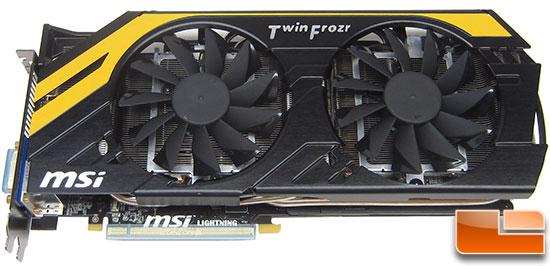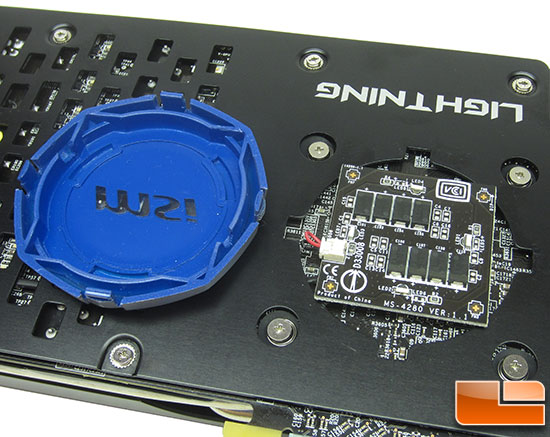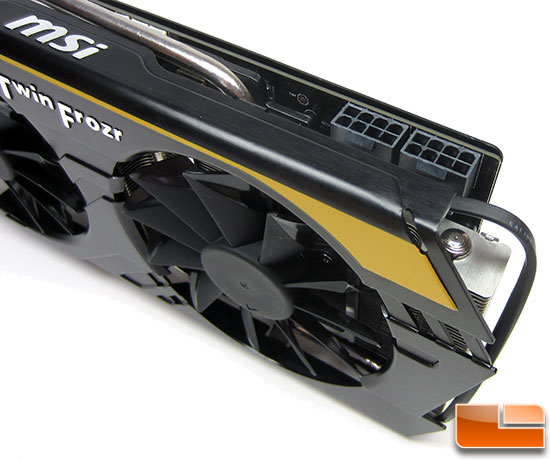MSI R7970 Lightning Radeon HD 7970 3GB Video Card Review
MSI R7970 Lightning – AMD Radeon HD 7970
Earlier this month MSI launched the companies AMD Radeon HD 7970 based Lightning series video card, the R7970 Lightning. The MSI Lightning series takes high-end graphics cards and turns them into monsters with custom PCB designs as well as GPU coolers and then includes top-quality components that increase the cards stability and endurance, making it ideal for overclocking purposes. When AMD first released the AMD Radeon HD 7970 3GB video card in December 2011 we were impressed with the card with the stock cooler and the 925MHz core and 1375 MHz (5500 MHz effective) GDDR5 memory clock speeds. The MSI R7970 Lightning might be three months late to the game, but this card might be worth the wait for AMD fans that didn’t want to buy the reference design. The MSI R7970 Lightning is clocked at 1070 MHz on the core and 1400 MHz on the memory (5600 MHz effective). This is an impressive 15.7% clock increase on the core and a mediocre 1.8% on the memory.

Looking at the front of the MSI R7970 Lightning graphics card you’ll see a video card that looks nothing like the AMD Radeon HD 7970 reference design. MSI engineers came up with their own PCB design and GPU cooling solution for this card, so it has been designed from the ground up to be more robust. MSI has included Military Class III components on it along with the Twin Frozr IV dual-fan cooler. On the custom PCB, MSI beefed up the power design to a 14+2+1 Phase PWM solution! With a 17 phase PWM design and a digital PWM controller, the MSI R7970 Lightning can offer more current output to the GPU and memory to ensure. On top of that MSI allows for the voltage adjustment of the GPU, Memory and the PCIe slot with the MSI Afterburner utility. MSI has done a number of things to make this card stand out from the crowd!
The MSI R7970 Lightning graphics card sports a black and yellow fan shroud that helps give it an aggressive look. The PCB of
the card measures 11-inches in length and stands at 4.75-inches in height. It should be
noted that the metal fan shroud extends past the PCB, so the true length of the card is ~11.75″ in length and the height of the card up to ~5″ in
height.

The first feature of the MSI R7970 Lightning that you should notice is the new Twin Frozr IV Heatsink. This brand new GPU cooler has two 100mm ‘propeller blade’ PWM fans to help keep the GPU and surrounding areas nice and cool. The previous Twin Frozr III GPU cooler used 80mm fans, so the fans have gotten significantly larger.

The fan blades have air channels located along the the edge of the fan blades that help increase the surface area. MSI says that this adjustment increased airflow by 20% compared to conventional fan. MSI also uses dust removal technology with the Twin Frozr IV, which means that when you turn the system on the fans spin in reverse for 30 seconds to blow the dust out and then return to the regular spinning direction.
If you look closely at the 10cm PWM fan in the image above you’ll see a small green LED light diode between the fan blades. Each fan has a single blue LED light that is on when the card is running.

The Twin Frozr IV GPU cooler uses also has a large nickel-plated copper heatsink base and five large heat pipes to help to dissipate heat rapidly away from the GPU. Notice that two of the heat pipes are 8mm thick and the three inner heat pipes are 6 mm thick. Also, two of the heat pipes go up and then down into the cooling fin array, while the other three go down and then turn back up into the cooling fins. MSI has heat pipes going in all directions!

Here is a slide that MSI provided on the Twin Frozr IV cooling solution.

Turning the MSI R7970 Lightning video card over we find that MSI is using a very nice metal backplate and we see a weird looking blue and silver plastic cap over the back of the GPU. The serial number sticker is also located on the back of the R7970 Lightning on the backplate, so if you take it off be sure you don’t lose it!

The MSI R7970 Lightning has a feature called GPU Reactor, which is located under that blue and silver plastic cap that easily pops off the back of the card. The GPU Reactor is designed to supply extra GPU power for maximum overclocking stability. It also helps to eliminate GPU power noise (ripple) and already installed when you buy a R7970 Lightning card. The image above shows what the GPU Reactor PCB looks like and as you can see it has eight tantalum capacitors on it with a power feed on the going into the side of the PCB.

If you don’t want to use the GPU Reactor you can simply unplug it and not use it. When we first got the MSI R7970 Lightning we thought this was nothing more than a marketing gimmick and something that could have been placed on the PCB rather than a daughter PCB card. We reached out to MSI to get a comment on the GPU Reactor and why it wasn’t placed on the PCB to begin with.
“The GPU reactor is meant to be an add-on board that provides additional power to the GPU for extreme overclocking such as LN2. We could have just added it on the regular PCB, but as you may notice, the PCB is already overcrowded with the existing amount of power phases thrown on. So to answer your question: this was the best way to add additional power circuitry to the card, without making the card absurdly large (i.e. keeping it within a 2-slot design). Thus, the decision was made to have it as an add-on PCB for LN2 overclocking, and for regular usage (especially SLI configurations) the user can remove it to prevent the card from taking up 3 slots. I hope this answers your question on that. For regular overclocking on air, the GPU reactor is not needed to achieve maximum OC, but it most certainly does not hurt…” – MSI USA
As you can see if you only plan on air cooling this is a pointless feature, but would help those that plan on overclocking with sub-zero cooling methods like LN2. We measured and found that MSI is using standard 53mm mounting
holes, so if you plan on changing the GPU cooler or adding a water block
at a later date you can easily do so and this is the dimension you need to be
concerned with.

Along the top edge of the MSI R7970 Lightning you’ll find three voltage check points that you can plug your volt meter directly into to get accurate readings. From left to right you have the V-GPU, V-MEM and V-VDDCI check points. You can adjust the GPU, Memory and VDDCI voltage settings in afterburner and then check the readings here without having to do any hard mods on the PCB itself! The MSI Afterburner utility also shows the temperature of the GPU, Memory and VRM (MOSFET) in the utility.

MSI includes the three cables that are needed to check the voltages with your multimeter probes!

When it comes to video outputs the MSI R7970 Lightning has four gold colored mini-DisplayPort connectors, a single-link DVI-I and a single-link DVI-D outputs. All AMD Radeon HD 7970 cards support up to six DisplayPort displays and this card is no exception. When we plugged our Dell 30-inch monitor in by using one of the DVI ports we quickly remembered that neither are dual-link and they won’t run at 2560×1600 due to obvious limitations. If you have a Dual-Link DVI monitor that only offers Dual-Link DVI, you’re going to need an Active DisplayPort to Dual-Link DVI connector. MSI does include a mini-DisplayPort to HDMI adapter with the card, so that will keep most people from having to buy adapters.

Just like other AMD Radeon HD 7970 cards, the MSI R7970 Lightning two CrossFire interconnects and you can link up to four of these cards together for improved performance. If you look just to the left of the CrossFire interconnects you can see the dual BIOS switch that allows you to change between two BIOS versions if you like.

Since the MSI R7970 Lightning is a tad bit different from your ordinary AMD Radeon HD 7970 reference design card, it needs a little more power. MSI has fitted the R7970 Lighting with two 8-pin power connectors. MSI says that the R7970 Lighting requires a 6500W or greater power supply with two 150W 8-pin PCIe connectors. With 300 Watts of power coming though the 8-pin connectors and 75 Watts through the PCI Express x16 slot, this means this card has a total of 375 Watts that it can bring it when needed! Good think MSI is using their Military Class III components (CopperMOS, Hi-C capacitors, golden solid state chokes and dark solid capacitors) as they might be needed after this card is punished with some extreme overclocks.

Comments are closed.